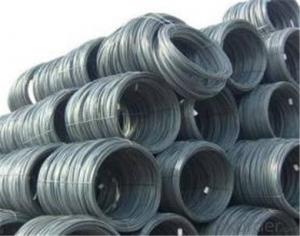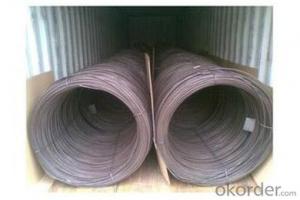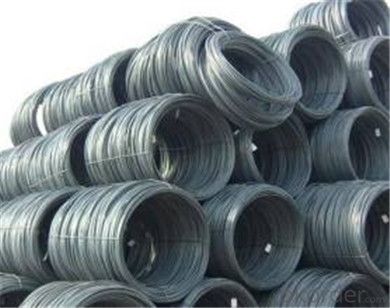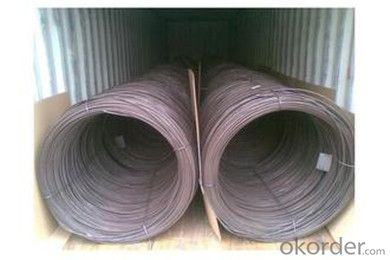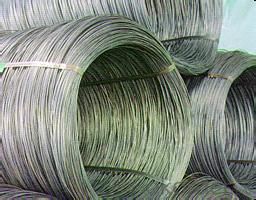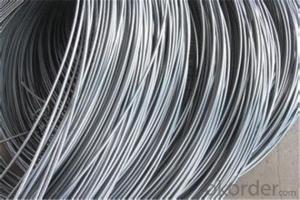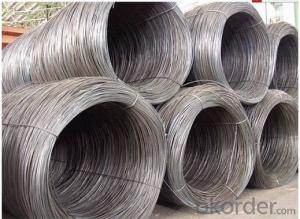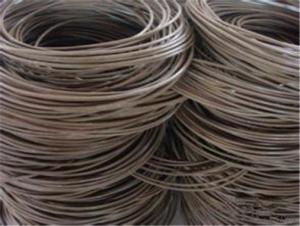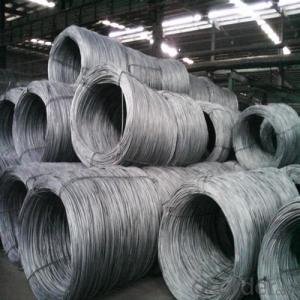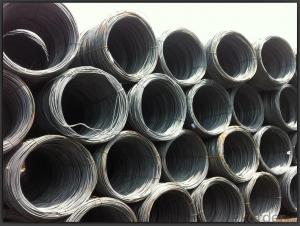SAE1006B Hot Rolled Steel Wire Rod 6.5mm with in China
- Loading Port:
- Tianjin
- Payment Terms:
- TT OR LC
- Min Order Qty:
- 500 m.t.
- Supply Capability:
- 45555555 m.t./month
OKorder Service Pledge
OKorder Financial Service
You Might Also Like
Specification
Description of wire Rod:
Our company is recognized by ISO9001:2008
1. hot rolled wire rod
2. material: Q195-235
Festures of wire Rod:
1. Drawn wire specialist, your wire rod solution
2. ISO9001 Certified Mill &SGS
3. Feature: machinability, high hardness, toughness, corrosion resistant
Specifications of wire Rod:
Product | steel wire rod |
Standard | AISI, ASTM, BS, DIN, GB, JIS |
Material/steel grade | Q195-Q235,SAE1006, SAE1008, SAE1010, SAE1018, SAE1020 or according to customers requirements |
Wire Gauge | 5.5-12mm |
Coil weight | 1.8-2.1mts |
MOQ | 25MT |
Delivery Time | 15-30 days after receipt of L/C or deposit by T/T |
Packing | In coil and load in container, if large quantity, by bulk vessel; Can be packed as customers' special requirements |
Payment terms | 1).100% irrevocable L/C at sight. |
Application | widely used in machinery parts, manufacturing industry, electronics industry, metal tools and others |
Images of wire Rod:
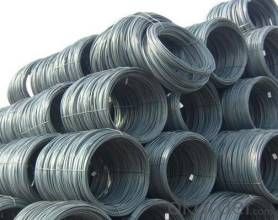
FAQ:
1. What is your package?
Packing situation: standard seaworthy packing or as customer required.
2. How long is the lead time?
Delivery time: 45 days after order confirmed.
3. What payment term do you accept?
Payment: T/T or L/C at sight.
- Q: What are the different types of tests performed on steel wire rod?
- There are several types of tests performed on steel wire rod to ensure its quality and suitability for various applications. These tests include: 1. Chemical Composition Analysis: This test determines the percentage of different elements present in the steel wire rod, such as carbon, manganese, silicon, sulfur, phosphorus, and other trace elements. It helps to ensure that the steel meets the required specifications. 2. Tensile Strength Test: This test measures the ability of the steel wire rod to withstand tension or pulling forces without breaking. It determines the maximum load the rod can bear before it fractures, providing crucial information about its strength and durability. 3. Elongation Test: This test determines the percentage increase in length the steel wire rod undergoes before it breaks under tension. It helps to assess the ductility and malleability of the rod, indicating its ability to withstand deformation without fracturing. 4. Hardness Test: This test measures the resistance of the steel wire rod to indentation or scratching. It provides an indication of the material's strength and ability to resist wear and tear. 5. Microstructure Analysis: This test involves examining the microstructure of the steel wire rod under a microscope. It helps to identify any structural anomalies, such as grain size, presence of inclusions, and uniformity, which can affect the rod's mechanical properties. 6. Surface Inspection: This test involves visually inspecting the surface of the steel wire rod for any defects, such as cracks, scratches, or surface irregularities. It ensures that the rod meets the required visual quality standards. 7. Dimensional Inspection: This test verifies the dimensional accuracy and tolerances of the steel wire rod, such as diameter, length, and straightness. It ensures that the rod meets the specified dimensional requirements for its intended application. 8. Corrosion Resistance Test: This test evaluates the steel wire rod's ability to resist corrosion when exposed to different environmental conditions. It helps to determine the rod's suitability for applications where corrosion resistance is critical. By performing these tests, manufacturers can ensure that the steel wire rod meets the necessary quality standards and is suitable for use in various industries, including construction, automotive, manufacturing, and infrastructure.
- Q: How is the surface roughness of steel wire rod controlled during manufacturing?
- The surface roughness of steel wire rods is controlled during manufacturing through various processes and techniques. One of the primary methods used is the selection of appropriate raw materials. High-quality steel with a specific chemical composition and controlled impurities is chosen to ensure a smoother surface finish. During the manufacturing process, the wire rod undergoes several mechanical treatments to achieve the desired surface roughness. These treatments include hot rolling, cold drawing, and heat treatment. Hot rolling is the initial step where the steel is heated and passed through a series of rolling mills. This process helps in reducing the surface roughness by eliminating surface defects and improving the overall surface finish. Cold drawing is another crucial step that involves pulling the wire rod through a series of dies at room temperature. This process further refines the surface finish and reduces the roughness by removing any residual scale or imperfections. Heat treatment is often employed after the cold drawing process to enhance the mechanical properties of the wire rod. It involves controlled heating and cooling cycles, which can also help in improving the surface finish by reducing any remaining surface irregularities. Additionally, surface treatments such as pickling, shot blasting, or chemical cleaning may be employed to remove any remaining oxide layers or contaminants on the surface of the wire rod. These treatments further reduce the surface roughness and enhance the overall appearance of the product. Regular quality control inspections and measurements are conducted during the manufacturing process to ensure that the desired surface roughness specifications are met. These inspections may include visual inspections, dimensional measurements, and surface roughness testing using instruments such as profilometers. In summary, the surface roughness of steel wire rods is controlled during manufacturing through careful selection of raw materials, mechanical treatments like hot rolling and cold drawing, heat treatment, surface treatments, and rigorous quality control measures. These techniques ensure that the final wire rod product has a smooth surface finish and meets the required specifications.
- Q: What are the common material specifications for steel wire rod?
- The common material specifications for steel wire rod are typically determined by the specific requirements of the industry or application in which the wire rod will be used. However, there are some general material specifications that are commonly found in steel wire rod. One of the most important material specifications for steel wire rod is its chemical composition. Steel wire rod is typically made from carbon steel, which contains varying amounts of carbon and other alloying elements such as manganese, silicon, and sulfur. The exact composition of the steel wire rod will depend on the desired mechanical properties and the intended application. Another important material specification for steel wire rod is its size and shape. Steel wire rod is generally produced in coils with diameters ranging from a few millimeters to several centimeters. The specific size and shape of the wire rod will depend on the requirements of the end product, such as the desired strength, flexibility, and conductivity. Furthermore, the mechanical properties of the steel wire rod are also specified. These properties include the tensile strength, yield strength, and elongation, which determine the wire rod's ability to withstand forces and deformations without breaking. The mechanical properties are typically achieved through specific manufacturing processes and heat treatments. Other common material specifications for steel wire rod may include surface quality requirements, such as smoothness, cleanliness, and absence of defects. Additionally, certain industries or applications may have specific requirements for corrosion resistance, electrical conductivity, or thermal conductivity, which would also be specified. It is important to note that the exact material specifications for steel wire rod can vary significantly depending on the specific industry or application. Therefore, it is crucial to carefully review the requirements and consult industry standards or experts to ensure the appropriate material specifications are met for the intended use of the steel wire rod.
- Q: What are the main competitors of steel wire rod?
- The main competitors of steel wire rod include aluminum wire rod, copper wire rod, and other non-ferrous metal wire rods. Additionally, synthetic materials like fiberglass and carbon fiber also pose competition in certain industries where lightweight and high-strength alternatives are preferred.
- Q: How is steel wire rod used in the manufacturing of wire for electrical applications?
- Steel wire rod is used in the manufacturing of wire for electrical applications as it serves as the raw material for producing electrical wires. The steel wire rod is processed through various stages, such as drawing, annealing, and coating, to transform it into a high-quality and reliable wire that can conduct electricity effectively. This wire is then utilized in the production of electrical cables, wiring harnesses, and other electrical components, enabling the transmission of electricity in a safe and efficient manner.
- Q: How is steel wire rod used in the manufacturing of wire rope assemblies for mining applications?
- Steel wire rod is an essential element in the production of wire rope assemblies used in mining operations. These assemblies are utilized for lifting and transporting heavy loads, ensuring stability and support, and guaranteeing worker safety. To manufacture steel wire rod, the initial step involves melting steel scrap in a furnace and continuously casting the molten steel into billets or blooms. These billets are then hot rolled into long, slender rods with diameters ranging from a few millimeters to several centimeters. Once the steel wire rod is produced, it undergoes a series of processes to convert it into wire rope. Wire drawing is the first step, where the rod is pulled through a series of dies to reduce its diameter and increase its length. This process also enhances the wire's surface finish and mechanical properties. Following wire drawing, a lubricant is typically applied to the steel wire to reduce friction and enhance corrosion resistance. This lubricant also provides protection during subsequent manufacturing processes. Next, the wire is twisted together to form strands. The specific application and required strength of the wire rope assembly determine the number of strands and the design of the twist pattern. The strands are then helically laid around a central core, providing additional strength and support. Finally, the wire rope assembly undergoes a process called closing, where the entire length of the assembly is compressed to ensure tightness and secure holding of all the strands. This closing process also improves the overall structural integrity of the wire rope assembly. In mining applications, wire rope assemblies made from steel wire rod are employed in various ways. They are commonly used in hoisting systems for lifting heavy loads, including equipment, ore, and personnel. These assemblies also serve suspension and support purposes, providing stability to underground tunnels and shafts. Furthermore, wire rope assemblies are utilized in safety applications, such as fall protection systems and rescue operations. Overall, steel wire rod plays a vital role in manufacturing wire rope assemblies for mining applications. Its strength, durability, and flexibility make it an ideal material for withstanding the demanding conditions and heavy loads commonly encountered in the mining industry.
- Q: What are the common production processes for nitrogen-coated steel wire rod?
- The common production processes for nitrogen-coated steel wire rod typically involve pre-treatment, nitrogen coating, cooling, and final inspection. The pre-treatment process includes cleaning the wire rod to remove any impurities or contaminants. Next, the wire rod is fed into a nitrogen coating machine where a layer of nitrogen is applied to the surface, enhancing its durability and corrosion resistance. After the coating is complete, the wire rod is cooled using water or air to ensure the coating adheres properly. Finally, a thorough inspection is conducted to ensure the quality and specifications of the nitrogen-coated steel wire rod are met.
- Q: What are the different types of steel wire rod surface defect prevention and control measures?
- There are several measures to prevent and control surface defects in steel wire rods. Some of these include proper cleaning and descaling processes before rolling, using high-quality raw materials, maintaining optimal rolling parameters, implementing effective cooling systems, and regularly inspecting and maintaining the rolling mill equipment. Additionally, employing advanced technologies such as electromagnetic stirring and lubrication systems can help minimize surface defects in steel wire rods.
- Q: What are the national standards for steel wire rod?
- The national standards for steel wire rod vary from country to country. Each country typically has its own set of standards governing the composition, quality, and production of steel wire rod. These standards ensure that the wire rod meets the necessary requirements for strength, durability, and performance in various applications. It is important for manufacturers and consumers to adhere to these standards to ensure the safe and reliable use of steel wire rod in different industries.
Send your message to us
SAE1006B Hot Rolled Steel Wire Rod 6.5mm with in China
- Loading Port:
- Tianjin
- Payment Terms:
- TT OR LC
- Min Order Qty:
- 500 m.t.
- Supply Capability:
- 45555555 m.t./month
OKorder Service Pledge
OKorder Financial Service
Similar products
Hot products
Hot Searches
Related keywords
